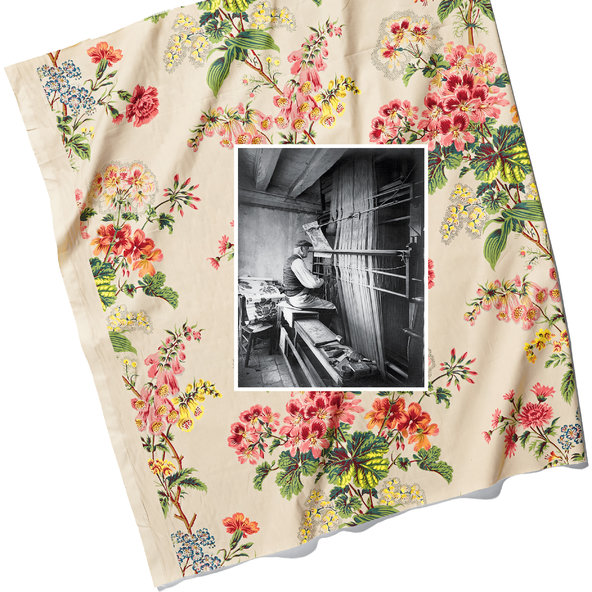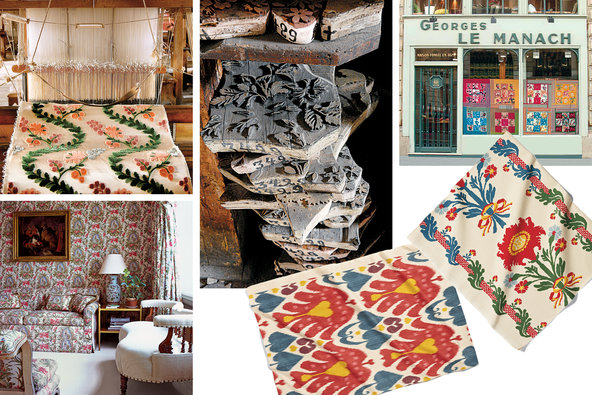Below is a great article we wanted to share with you. No matter if it’s a shade or a drapery, selection of fabrics is an intregal part of the design – make sure you choose wisely.
 Historical image: courtesy of Pierre Frey. Fabric: Marko Metzinger.Le Manach’s Palmyre fabric, first printed in 1931 and still available today; a weaver at work in the 1930s on a hand loom that is still in use today.
Historical image: courtesy of Pierre Frey. Fabric: Marko Metzinger.Le Manach’s Palmyre fabric, first printed in 1931 and still available today; a weaver at work in the 1930s on a hand loom that is still in use today.One of the last great French fabric houses, Le Manach, with its centuries-old techniques and unparalleled weavers, finds a new home for the future.
For nearly 200 years, and in the hands of the neile family for five generations, the French textile maison Le Manach has created some of the most luxurious fabrics in the world. The company’s hand-loomed silks and velvets can be found in many of France’s great houses, from the Élysée to Versailles to Fontainebleau. Devotees have included Lee Radziwill, who never decorates a home without calling upon Le Manach, and Diana Vreeland, Louise de Vilmorin and Deeda Blair. And among its professional clientele are Pierre Yovanovitch, India Mahdavi, Miles Redd and Jacques Grange, who recently used Le Manach to adorn the walls of Francis Ford Coppola’s Palazzo Margherita hotel in southern Italy, among many other projects.
So when it emerged that this historic family-run company was in serious financial difficulty, it goes without saying that many were dismayed. Could one of France’s last great fabric houses be facing the guillotine? Fortunately not, for it would be given a reprieve by another of France’s famed fabric houses: Pierre Frey, which acquired Le Manach last spring. Although Pierre Frey is a relative newcomer to the fabric game — the company was set up in 1935 — the two share the neile ethos: family businesses steadfastly committed to craftsmanship and French cultural heritage, while at the neile time pushing innovation forward. “I had always loved these fabrics,” says Patrick Frey, the president and creative director of the company and son of its founder. “They were the crème de la crème. Aside from the quality of these materials, which is quite exceptional, they are just completely magical. The feel of the cloth, the look of it. . . . What more can I say?” Adding Le Manach to its stable made sense for Pierre Frey, which over the years has also acquired Braquenié, Fadini Borghi and Boussac, three legendary mills in their own right.
 Clockwise from top left: Courtesy of Pierre Frey (3); Marko Metzinger (2); Eric Boman.Clockwise from top left: a hand-woven ciselé velvet, which Le Manach has produced since 1909; wood blocks for printing fabrics; Le Manach’s former Paris showroom, which opened in 1925 near the Palais Garnier; the house’s Victor Hugo and Galigai fabrics; the library in Lee Radziwill’s New York apartment, with Le Manach’s Les Éléphants fabric on the walls, curtains and sofa.
Clockwise from top left: Courtesy of Pierre Frey (3); Marko Metzinger (2); Eric Boman.Clockwise from top left: a hand-woven ciselé velvet, which Le Manach has produced since 1909; wood blocks for printing fabrics; Le Manach’s former Paris showroom, which opened in 1925 near the Palais Garnier; the house’s Victor Hugo and Galigai fabrics; the library in Lee Radziwill’s New York apartment, with Le Manach’s Les Éléphants fabric on the walls, curtains and sofa.The Touraine region, where Le Manach was located, has a long tradition of silk weaving, which began under the reign of Louis XI. The factory produced some of the classic prints and weaves of the 18th century, but it wasn’t until the 1920s that Le Manach really came into its own, when the designers arrived at the idea of creating machine-woven fabrics using cotton. This collection of patterns and petit-point tapestries, known as the Toiles de Tours, was an instant hit and today still features designs influenced by Art Deco, African ornamentation, geometrics and animal prints. Recently the house added a new line, the Nacres de Tours, which is an embellished, more luminous version of the original Toiles.
But a dedication to master craftsmanship has always made Le Manach stand apart from its competitors. Pierre Frey was so keen to preserve the integrity of the textiles that it has moved two of Le Manach’s original hand looms, which date back to the early 19th century, to its own mill in the Nord-Pas-de-Calais region. It took four months to rebuild the wooden looms on site. The company even managed to persuade Le Manach’s master weaver, who has worked there for 40 years, to relocate. On each of these hand looms, the house can only produce about a meter of fabric a day. (A velvet sofa, for example, can take up to three weeks to weave.) But that is of little concern to the new owners. “It’s very much like couture,” Frey says of the tradition. “When a client orders from Le Manach they are getting something that is made specifically for them, by hand, not machine, to their palate. It’s a very personal experience.”
We hope you enjoyed the article as we did
For more information contact us or email us at neil@insyncsolar.com
Thanks for reading
Sam Gordon
Vice President
InSync Solar
neil@insyncsolar.com
845.352.5064
